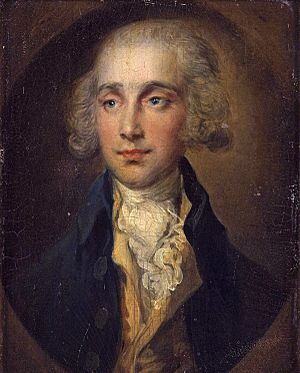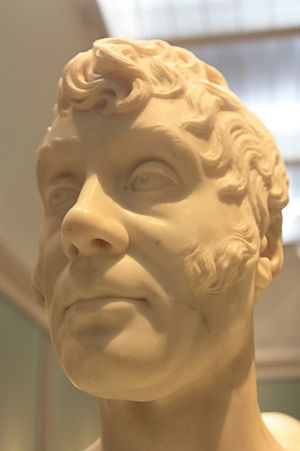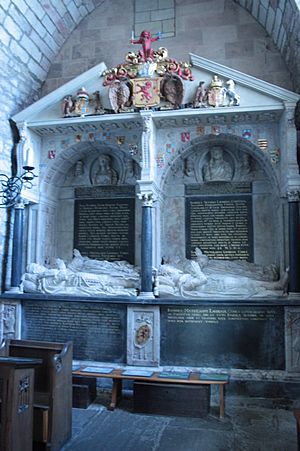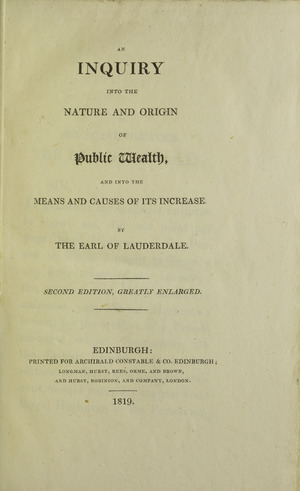James Maitland, 8th Earl of Lauderdale facts for kids
Quick facts for kids
The Earl of Lauderdale
|
|
|---|---|
 |
|
| Earl of Lauderdale | |
| Reign | 17 August 1789 – 10 September 1839 |
| Predecessor | James Maitland, 7th Earl of Lauderdale |
| Successor | James Maitland, 9th Earl of Lauderdale |
| Born | 26 January 1759 |
| Died | 10 September 1839 (aged 80) |
| Spouse(s) | Eleanor Todd |
| Issue | 10 |
| Father | James Maitland, 7th Earl of Lauderdale |
James Maitland, the 8th Earl of Lauderdale (born January 26, 1759 – died September 10, 1839), was an important Scottish politician and writer. He held the role of Keeper of the Great Seal of Scotland, which was like a chief legal officer. He also served as a representative peer for Scotland in the House of Lords, meaning he was chosen by other Scottish nobles to represent them in the British Parliament.
| Top - 0-9 A B C D E F G H I J K L M N O P Q R S T U V W X Y Z |
Early Life and Education
James Maitland was born at Haltoun House near Ratho, Scotland. He was the oldest son of the 7th Earl of Lauderdale, whom he replaced as Earl in 1789.
He studied at the universities of Edinburgh and Glasgow. He then finished his education in Paris, France. During his time in Paris, it is believed he became interested in new, radical ideas about politics and society.
Starting a Political Career
When James Maitland returned to Scotland in 1780, he became a lawyer. In the same year, he was elected to the British Parliament.
From 1780 to 1784, he was a Member of Parliament (MP) for Newport. Then, from 1784 to 1789, he was an MP for Malmesbury. In the House of Commons, he supported a leading politician named Charles James Fox, who was part of the Whig political group. James Maitland was very active in debates and even helped manage the trial of Warren Hastings, a former British official in India.
Joining the House of Lords
In 1789, James Maitland became a member of the House of Lords, which is the upper house of the British Parliament. He was a representative peer for Scotland, meaning he was elected by other Scottish nobles to represent them.
In the House of Lords, he strongly opposed the policies of Prime Minister William Pitt the Younger, especially those related to France. He often spoke out against laws like the Habeas Corpus Suspension Act and the Sedition Bill, which limited people's freedoms. When the French Revolution began, he was seen as sympathetic to it. He even famously appeared in Parliament wearing clothes that looked like those worn by French revolutionaries.
In July 1792, he had a duel with Benedict Arnold, a famous American general who had switched sides during the American Revolution. Luckily, no one was hurt in the duel.
Experiences During the French Revolution
In 1792, Lord Lauderdale traveled to France again with a doctor named John Moore. He arrived in Paris just three days before the attack on the Tuileries palace and the imprisonment of King Louis XVI.
After the terrible massacres of September 2nd, the British ambassador left Paris. Lord Lauderdale also left for Calais on September 4th. However, he returned to Paris the following month and stayed until December 5th. After his return to London, he wrote a book about his experiences called Journal during the residence in France from the beginning of August to the middle of December 1792.
He was known as 'Citizen Maitland' because of his strong support for the French Revolution. He was even friends with Jean-Paul Marat, a famous French revolutionary leader. Lord Lauderdale also helped create the British Friends of the People Society in 1792, which supported political reform in Britain.
New Titles and Roles
In February 1806, when a new government was formed, Lord Lauderdale was given a new title: Baron Lauderdale of Thirlestane. This made him a peer of the United Kingdom, which is a higher rank of nobility. He also became a member of the Privy Council, a group of advisors to the King.
For a short time starting in July 1806, he served as the Keeper of the Great Seal of Scotland.
Peace Talks with Napoleon
On August 2, 1806, Lord Lauderdale, who spoke French fluently, went to France. He had the authority to negotiate a peace treaty with Napoleon and his foreign minister, Tallyrand. Another British diplomat, the Earl of Yarmouth, had already been working on the talks.
Lord Lauderdale arrived on August 5th and joined Yarmouth in the difficult task of negotiating. Yarmouth was called back to Britain on August 14th, leaving Lauderdale to continue alone.
A famous French detective, Eugène François Vidocq, wrote in his memoirs that during the Battle of Copenhagen (1807), the French city of Boulogne was bombed. According to Vidocq, Lord Lauderdale was in Boulogne at that time and was almost attacked by angry French citizens.
After the peace talks failed and fighting started again, Lord Lauderdale left Paris for London on October 9th. The details of the negotiations were published in the London Gazette on October 21, 1806.
Later in his career, Lord Lauderdale changed his political views. After leading the Whigs in Scotland, he became a Tory (a more conservative political group). He even voted against the Reform Bill of 1832, which brought major changes to the British voting system.
He was made a Privy Counsellor in 1806 and a Knight of the Thistle in 1821. The Order of the Thistle is a very old and important award in Scotland.
The Banner Dispute
Since 1672, the Earls of Lauderdale had the special right to be the Hereditary Bearer for the King or Queen of the Standard of Scotland. This meant they had the honor of carrying the Scottish national flag. This right continued until 1910.
In 1790, James Maitland, the 8th Earl of Lauderdale, officially registered his right to carry both the Standard of Scotland and the National Flag of Scotland.
In 1952, after discussions with the Earls of Lauderdale and Dundee, the Lord Lyon (Scotland's chief heraldic authority) advised Queen Elizabeth II to confirm that the Earl of Lauderdale had the right to carry the saltire (the blue flag with a white X). The Earl of Dundee was confirmed as the bearer of the Royal Standard, which is the flag with the lion rampant.
Important Writings
James Maitland wrote an important book called Inquiry into the Nature and Origin of Public Wealth (published in 1804 and again in 1819). In this book, he introduced an idea known as the "Lauderdale Paradox." This idea suggests that there's a connection between public wealth (like a country's overall resources) and private wealth (what individuals own). He believed that if one increases, the other might decrease.
This book was translated into French and Italian and caused some debate. He also wrote The Depreciation of the Paper-currency of Great Britain Proved (1812) and other similar works.
His "Inquiry" was one of the first books to look at how a government's budget (whether it has extra money or is spending more than it has) affects the economy. His ideas later influenced Keynesian economic theories, which are widely used today.
Death and Burial
James Maitland died at Thirlestane Castle, near Lauder, in Berwickshire, Scotland. He was 80 years old.
He is buried in the Maitland family vault, also known as the Lauderdale Aisle, at St Mary's Collegiate Church, Haddington.
Family Life

On August 15, 1782, James Maitland married Eleanor Todd (1762–1856). She was the only daughter and heir of Anthony Todd, who was the Secretary of the General Post Office.
They had ten children together:
- Lady Eleanor, who married James Balfour. Their son, James Maitland Balfour, became a Member of Parliament, and their grandson, Arthur Balfour, later became Prime Minister of the United Kingdom.
- Lady Mary, who married Edward Stanley.
- Lady Julia, who married Sir John Warrender, 5th Baronet in 1823.
- James Maitland, 9th Earl of Lauderdale (1784–1860), who became the next Earl.
- Admiral Anthony Maitland, 10th Earl of Lauderdale (1785–1863), who became the Earl after his brother.
- Five other sons.
It is noted that none of their seven sons ever married.
Works
- An Inquiry into The Nature and Origin of Public Wealth and into the Means and Causes of its Increase 1804 (second edition 1819)




